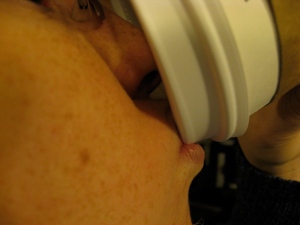Tags
Quick quiz: where’s your philtrum?
A word obscure enough it would probably make a good choice in a game of Dictionary/Balderdash – it is the little indentation in a person’s upper lip.
My husband tells me its origin according to Jewish lore has to do with our pre-natal education: in the womb, an angel tells us all the mysteries of life, and then presses a finger to our upper lips, creating the philtrum, and in that instant we forget. We spend our whole lives marked by that angel, trying to regain what we knew and lost before birth.
Lack of a philtrum is one of those mid-line birth defects (which I’ve written about in a post on tongue-ties ) that can arise from a toxic environment in the womb, such as in the case of fetal alcohol syndrome.
I first starting thinking about philtrums in the context of breastfeeding mechanics. For a comfortable and effective latch, a baby must flange both lips out and not pinch the breast. In this act, the philtrum is folded back against the nose, or even folded in half on itself – I can see an mild red horizontal crease in my daughter’s upper lip sometimes when she’s done nursing. The upper lip stays stationary while the lower lip moves along with the jaw and tongue to perform the suckling action.
One piece of breastfeeding advice sometimes given is to tickle the newborn’s philtrum with the nipple to induce them to tilt their heads up a bit, open wide and draw in the nipple into a nice asymmetrical latch. When the lower lip and jaw encompass more breast tissue than the upper, the baby is maximally effective at drawing milk from the breast by using the jaw movement and tongue action to compress milk ducts in a wave-like motion and bring the milk out.
The tilt of the baby’s head also opens up the throat for the easiest drinking experience (try sipping a cup of water with your head completely level versus tilting your chin up a bit, or imagine what you’d do if you really wanted to gulp back a drink).
Could it be that the philtrum is a landing strip of sorts? A mark for a mother to follow to know where to stimulate her new baby to nurse? Perhaps the natural feeding sequence is even more subconscious than this, but this doesn’t seem like a bad backup indicator.

Now, I have been trying to figure out if there is a difference in sensation between the lower lip and upper lip. It feels subjectively to me that the upper lip is more sensitive. All I can find by googling is that the lips are served by different nerves. The nerve that is responsible for upper lip sensation also serves the lower eyelids and the cheeks. The nerve for the lower lip serves the jaw and chewing muscles.
The high sensitivity of the philtrum led the ancient Greeks to name it with their word for love. And what love could be more primal than infants in their first years of life receiving regular pleasant sensations at their philtrum in association with warm milk and closeness with their mother? Of course we lose this ritual at weaning, only to rediscover some of the sensation in kissing once we are mature. But let me take this one step further. Let me take this to Starbucks.
Yes, Starbucks. Picture yourself stopping in to your local Starbucks, or even your friendly neighborhood non-Starbucks café. Think about ordering one of those fancy drinks – a warm one, it’s winter… something milky and sweet. Caramel macchiato? Vanilla latte? You get a to-go cup – not staying and you forgot your travel mug. Bring it to your lips to sip. Tilt your head back, purse your lips. Make contact with the lid – it’s smooth on your lips, and there’s that agreeable pocket where your upper lip slides in. But wait, are you pinching down with your upper lip? No – you are relaxing it and letting it curl up. Your philtrum is folding back on itself as you tilt your head up and drink in that sweet warm milk. You feel cozy and happy. You tip well.
Kind of takes you back, doesn’t it? (I should mention that human milk, and therefore also infant formula for human babies, is much sweeter than the milks of other mammals, due to the human brain’s intense carbohydrate requirements.) When we drink from an open mug, or a to-go cup with a coffee lid rather than a latte lid, we don’t get that familiar soft pressure on the upper lip. I won’t even comment on how those who were weaned too young may have an unfulfilled need for this stimulation. Starbucks has addicted us to expensive lattes by tickling our philtrums!
I’ll leave you with a shot of my ugly “mug” having a “shot” of some fancy drink or other!

